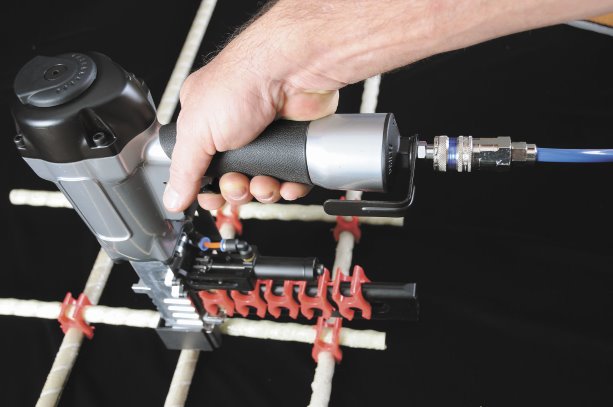Traditionally, construction crews tie rebar together with wire twist and it’s a pain both figuratively and literally.
It’s a pain in that it’s a time consuming job and physically, it can trigger carpal tunnel injuries, lower back issues and even cause cuts as a worker’s skin gets scratched by the sharp wire edges.
After 25 years in construction, American contractor Jon Kodi, who spent many hours on the job tying rebar together with his crew, threw down his wire cutters and said there had to be a better way.
There wasn’t…so he designed a system for tying rebar from the ground up himself. The Kodi Klip Rebar Fastening System started up in 2007 and is now in its third iteration of design.
It’s a simple system, consisting of a plastic clip, which grabs and locks on four points of the rebar intersection, a gun about the size of a drill gun and a carbon fibre bottle of compressed air with a hose supplying the gun. A rack of clips is fed through the gun automatically.
All told, the system weighs just four pounds, light enough to work without invoking fatigue said Kodi.
"I knew there had to be a better way," said Kodi. "Guys were getting wrist injuries and back injuries from bending down all day. Some were getting cut when they reach through the rebar and the wire twist caught them."
He said the air bottles are refillable on site from a master bottle and are good for about 400 shots.
"They’re also carbon fibre so they’re really lightweight," he said. "They hold about 4,500 pounds of air but they’re rated for 9,000 pounds."
The Kodi Klip system is gaining traction, he said, and avoids having to get all kinds of engineering approvals because they are only a temporary holding system. The clips, like the wire, provide no structural support and merely hold the rebar in place until the concrete can be poured. Once that concrete sets, the clips are redundant.
In Canada, the system is distributed by Profast in Hamilton, Ont. where John Millington says younger contractors are more likely to ask and use the system than the old school crews who still want to tie the rebar by hand.
"It’s a struggle with the U.S. dollar right now but the MTO (Ontario Ministry of Transportation) have approved it for bridge work. It’s faster, it’s an engineered product and it’s been tested, whereas tying hasn’t really been tested."
"They do have an advantage over wire in that they won’t scratch the rebar coating and allow corrosion in," Kodi said. "The clip locks it in like it’s been welded. We have the engineering firms specifying them at a bridge project in Tennessee."
The company is also working to get the California Department of Transportation to approve it, one of the few jurisdictions which sets standards for installation of rebar because of the seismic issues in California.
He said the system is unique in the marketplace.
"There was a system which was designed which would wrap wire but the company went bankrupt before it got into production," Kodi said.
While the cost of the unit is about US$900, it’s much cheaper over the long run because the speed of rebar installation is greatly enhanced.
"We had a contractor who budgeted and bid four days for an apron installation at an airport in Arizona," he said. "Using Kodi Klip they got it done in a day. That’s 30,000 joints. That was money in his pocket."
Kodi is now working on developing a patent he owns for an adjustable rebar chair which telescopes to laser accuracy and is stackable. He hopes to have that to market soon.











Recent Comments
comments for this post are closed